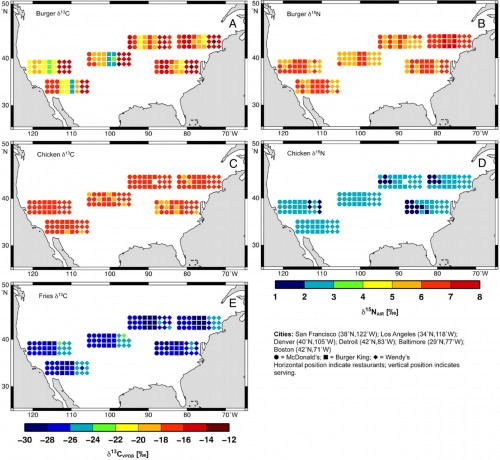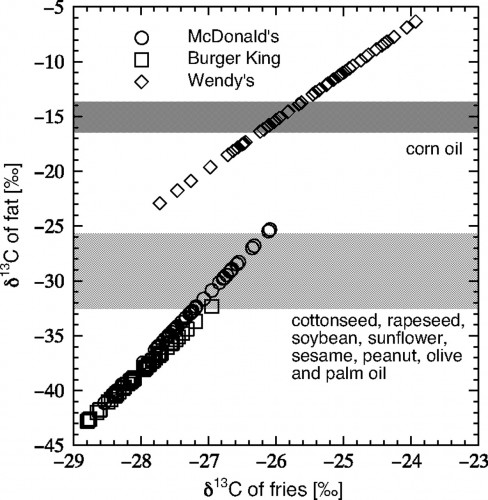Americans spend over 100 billion dollars on restaurant fast food each year; fast food meals comprise a disproportionate amount of both meat and calories within the U.S. diet. A chemical analysis of fast food staples such as hamburgers and French fries shows that the overwhelming majority of takeaway food is based on a single source–corn.

By purchasing and eating 1 serving of the subjects of this study (i.e., 1 hamburger, 1 chicken sandwich, and 1 small order of fries), the consumer has gained 50% of that day’s recommended calories, 80% of carbohydrates, 75% of protein (90% if the consumer is a woman), and the full day’s limit of dietary fat at a cost of $3 [based on the National Academy of Sciences 2005 Dietary Reference Intakes Series and the McDonald’s Dollar Menu].
As meat consumption has skyrocketed in the United States, the consumption of fast food has increased disproportionately. The production of fast food meat is a unique problem in cost-optimization: to accelerate meat production in animals, calorie consumption is maximized, and calorie expenditure is minimized. Meaning we cram as much food into them as possible, while keeping them confined into the smallest space available. This leads to the over use of antibiotics to keep them alive long enough to be slaughtered, and a whole host of other nasty problems (what would you do with a couple thousand gallons of poo every day…maybe make energy from it?)
Using a stable isotope analysis of carbon and nitrogen, Hope Jahren and Rebecca Kraft examined the food served at three fast food chains and identified corn as the ultimate food source in burgers, chicken, and fries. Corn has a unique carbon isotopic signature reflected in the meat of the animals that consume it. Jahren and Kraft sampled hamburgers, chicken sandwiches, and French fries at McDonald’s, Burger King, and Wendy’s, and found corn to be the almost exclusive food source of the beef and chicken served. Out of the 162 samples of beef, only 12 showed a food source other than corn (i.e., grass or grains). The authors also found high levels of stable nitrogen isotopes in both chicken and beef, demonstrating widespread usage of nitrogen-based fertilizers in the growth of animal feed. Analysis of the fat used to cook the French fries found that some restaurants used different oils than their ingredient statements claimed, and also found corn as a major ingredient. These results, say Jahren and Kraft, highlight the overwhelming importance of corn in every aspect of fast food production.

From the scientists:
We used carbon and nitrogen stable isotopes to infer the source of feed to meat animals, the source of fat within fries, and the extent of fertilization and confinement inherent to production. We sampled food from McDonald’s, Burger King, and Wendy’s chains, purchasing >480 servings of hamburgers, chicken sandwiches and fries within geographically distributed U.S. cities: Los Angeles, San Francisco, Denver, Detroit, Boston, and Baltimore. From the entire sample set of beef and chicken, only 12 servings of beef had δ13C < −21‰; for these animals only was a food source other than corn possible. We observed remarkably invariant values of δ15N in both beef and chicken, reflecting uniform confinement and exposure to heavily fertilized feed for all animals. The δ13C value of fries differed significantly among restaurants indicating that the chains used different protocols for deep-frying: Wendy's clearly used only corn oil, whereas McDonald's and Burger King favored other vegetable oils; this differed from ingredient reports. Our results highlighted the overwhelming importance of corn agriculture within virtually every aspect of fast food manufacture.
The problem with all this? Corn growing, at least in it’s current format (giant, mono-culture farms sustained using oil based fertilizers) is so unsustainable that it is killing large swaths of the natural world. It is also killing us, eating that much corn is not good for you. Clearly we need to change the way